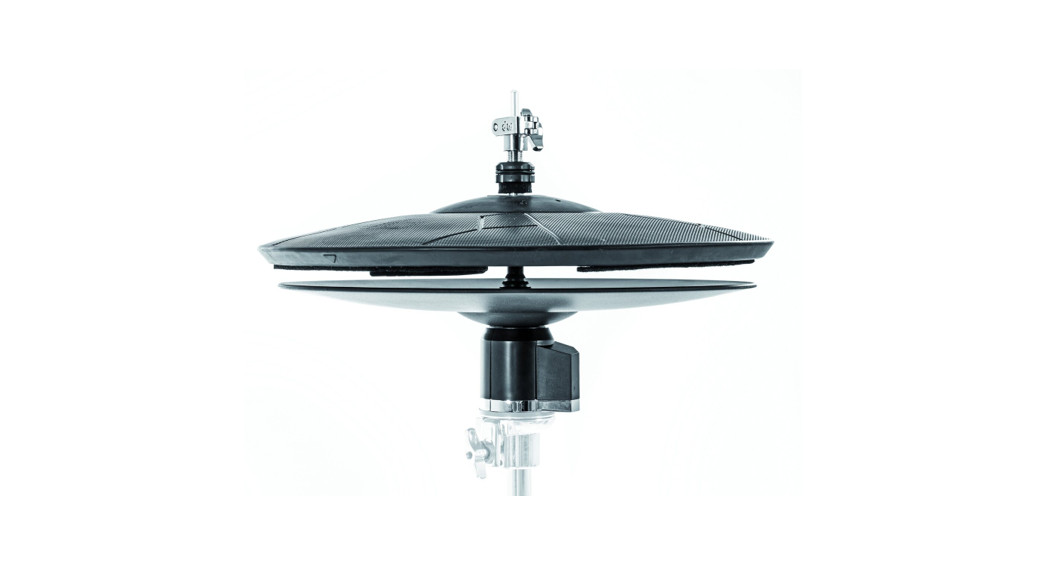 Owner´s ManualHC14HC14-ACHC14-TElectronic Hi-Hat Cymbals
Owner´s ManualHC14HC14-ACHC14-TElectronic Hi-Hat Cymbals
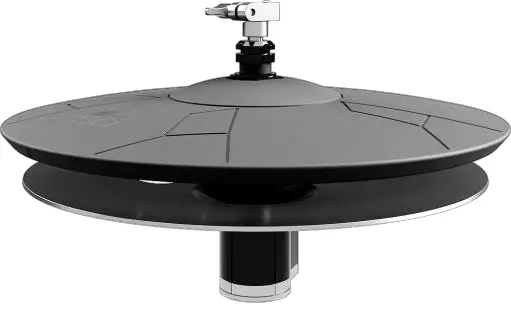

HC14 | HC14-AC | HC14-TElectronic Hi-Hat Cymbals
| Models | HC14 | HC14-AC | HC14-T |
| Document | Owner´s Manual |
| Version | 1.0 |
| Release Date | 2020-10-09 |
![]()
![]()


SAFETY INFORMATION
Failure to observe the following safety directives may result in fire, electric shock, injury, device damage, or damage of other objects or property. Read the following safety instructions completely before operating this product.Further risks are possible; therefore, the following list does not claim to be complete.About the symbols![]()
![]()
![]()
![]()
![]()
![]()
![]()
![]()
![]()
![]()
![]()
![]()
![]()
![]()
![]()
![]()
![]()
![]()
![]()
![]()
![]()
![]()
![]()
![]()
![]()
![]()
![]()
![]()
![]()
![]()
![]()
![]()
![]()
![]()
![]()
![]()
![]()
- Locations of high temperature (in direct sunlight. near heating equipment)
- Moist or humid locations (near a bath or shower, or a wet floor)
- Locations exposed to steam or smoke
- Locations subject to salt damage
- Locations subject to water or rain
- Expressively dusty or sandy environment
- Locations subject to high levels of vibration
- An environment with poor ventilation
![]()
![]()
![]()
![]()
![]()
![]()
![]()
![]()
![]()
![]()
![]()
![]()
![]()
![]()
![]()
![]()
![]()
![]()
![]()
![]()
![]()
![]()
![]()
![]()
![]()
![]()
![]()
![]()
![]()
![]()
![]()
![]()
![]()
![]()
![]()
![]()
![]()
![]()
![]()
![]()
![]()
![]()
![]()
![]()
![]()
![]()
![]()
![]()
![]()
![]()
![]()
![]()
![]()
![]()
![]()
![]()
![]()
![]()
![]()
![]()
![]()
![]()
![]()
![]()
![]()
![]()
![]()
![]()
![]()
![]()
![]()
![]()
![]()
![]()
![]()
![]()
![]()
![]()
![]()
![]()
![]()
![]()
![]()
![]()
![]()
![]()
![]()
![]()
![]()
![]()
![]()
![]()
![]()
![]()
![]()
![]()
- This unit may interfere with radio and television Do not use this unit in the vicinity of such receivers.
- When moved from one location to another where the temperature and/or humidity is very different, water droplets (condensation) may form inside the Damage or malfunction may result if you attempt to use the unit in this condition. Therefore, before using the unit, you must allow it to stand for several hours until the condensation has completely evaporated.
- Whenever any liquid has been spilled on the surface of this unit, be sure to promptly wipe it away using a soft, dry
- Spurs included with stands and pads might scratch the floor. Use a mat or similar, adequate object to protect the floors from damage.
- Make sure that children are not exposed to risks of injury caused by improper placement or setup of
Maintenance
- Never use benzene, thinners, alcohol, or solvents of any kind, to avoid the possibility of discoloration and/or deformation.
- Remove stick marks and dust by treating the top surface of the cymbal with a sponge lightly soaked in silicone oil. Silicone oil protects the top surface um! teslotes U rleSi I and even look.
- For every day, cleaning wipes the unit with a soft, dry cloth or one that has been slightly dampened with water. To remove stubborn dirt, use a cloth impregnated with a mild, non-abrasive detergent. Afterward, be sure to wipe the unit thoroughly with a soft, dry
Additional Precautions
- Use a reasonable amount of care when using the unit’s jacks and connectors. Rough handling can lead to malfunctions.
- When disconnecting all cables, grasp the connector itself – never pull on the cable. This way you will avoid causing cable breakage and short
- This instrument is designed to minimize the extraneous sounds produced when it’s played. However, impact noise still can be transmitted through floors and walls to a greater degree than expected, take care not to allow these sounds to become a nuisance to others nearby.
- Continuous playing may cause discoloration of the pad, but this will not affect the pad’s function.
DISPOSAL AND RECYCLING
EU Countries
![]()
![]()
PACKAGE CONTENTS
The original packaging contains the following items. Please check carefully the completeness of the purchased product:


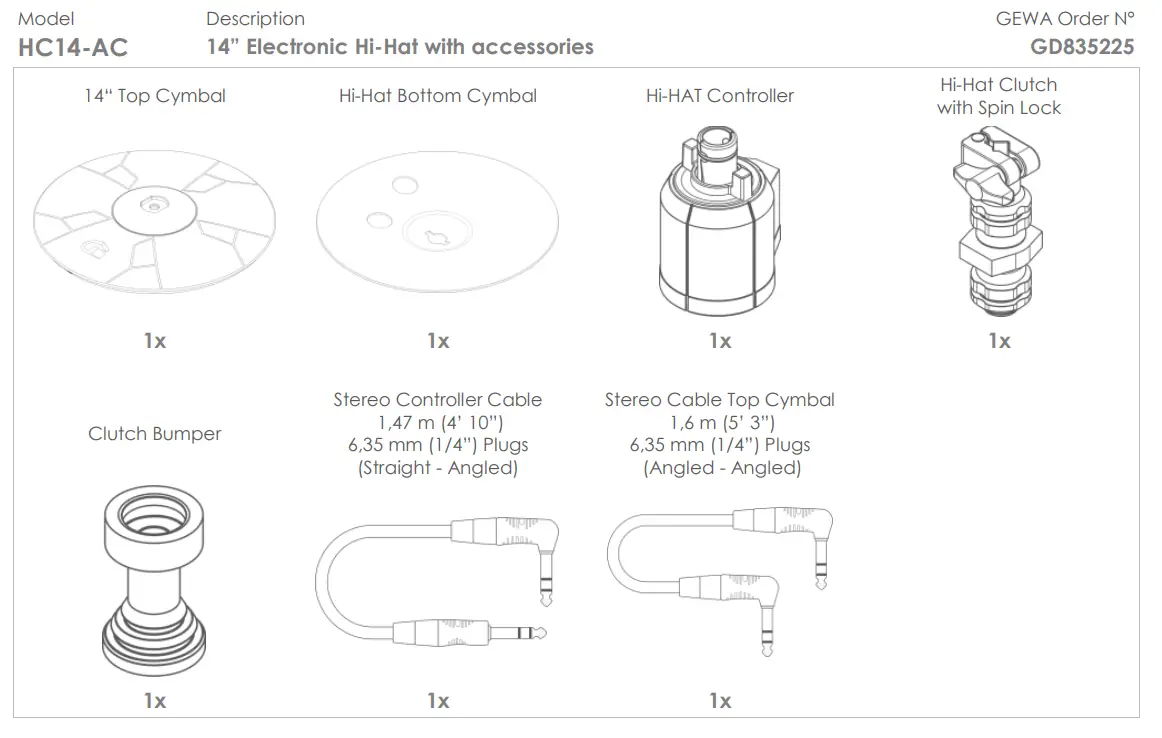



ASSEMBLY INSTRUCTIONS
Assembly top cymbal
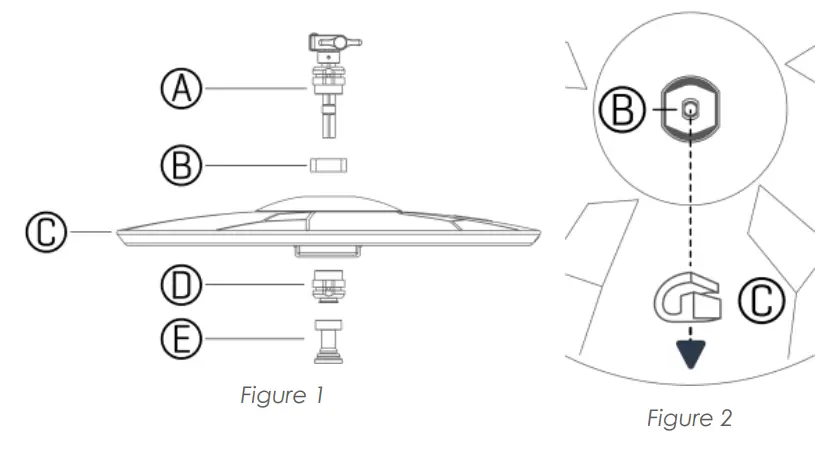

- Unscrew the bottom nut (D) from the Hi-Hat Clutch (A).
- Attach the spinlock (B) to the shaft of the top part of the clutch (A).
- Guide clutch and spin lock through the middle hole of the Top Cymbal (C).
- Orient the spinlock (B) inside the cymbal mold as shown in Figure 2.
- Screw the bottom nut (D) onto the shaft of Clutch (A) again and clip the clutch bumper (E) on the bottom nut (D).
- Lightly clamp the cymbal by fastening the top nut (A).
Assembly bottom cymbal


- Remove any felt padding from the Hi-Hat seat (M) of the stand (see also compatible stands).
- Place the steel washer (I) on the seat.
- (Optional) Only for Hi-Hat seats without pin (J): Attach the universal cymbal seat (I) to the hi-hat cymbal seat (M).
- Place the rubber washer (H) on either cymbal seat or universal cymbal seat.
- Guide the Hi-Hat Controller (G) over the Hi-Hat rod (L) and align hole (K) with pin (J).
- Place the Bottom cymbal (F) on the controller (G) and match the profiles around the middle hole.
- Loosen the clamp of the Hi-Hat stand top tube and orient the whole system. Arrow (A2) on the bottom cymbal should face the player. With the correct orientation, fasten the tube clamp again.
HC14 cable connections – Trigger Type Dual
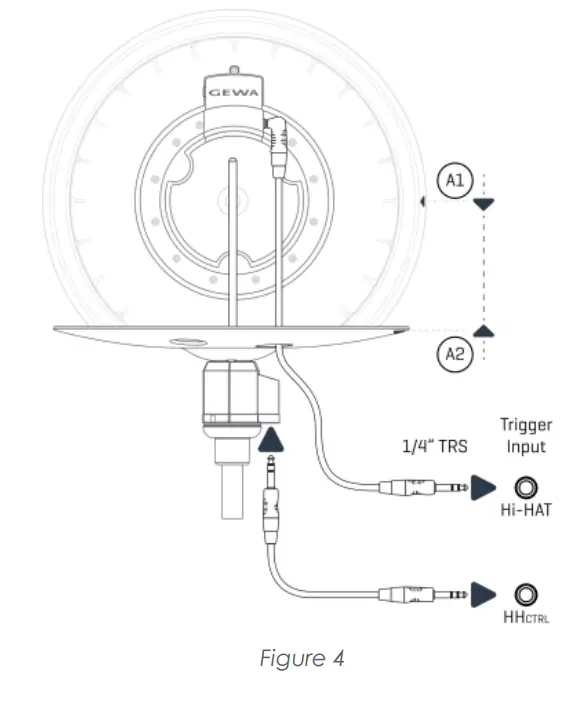

- Take the top cymbal (C) and connect the stereo cable (angled – angled) to the jack closest to the middle hole (see Figure 4).
- Guide the cable through the hole of the bottom cymbal which is closest to the Hi-Hat rod.
- Align the arrows (A1) and (A2) and guide the top cymbal over the HiHat rod, so that both cymbals rest on top of each other.
- Straighten the cable carefully if needed.
- Connect the straight plug of the Stereo Controller Cable to the Hi-Hat Controller as shown in Figure 4.
- Connect both cables to the corresponding Trigger Inputs of your drum console as shown in Figure 4. The naming convention regarding trigger Inputs might vary from manufacturer to manufacturer, but always offer individual inputs for Cymbal and Controller.
Height adjustment top cymbal (GEWA System)For the use with GEWA factory Trigger Banks, the top cymbal needs to be mounted high enough, so that the Clutch Bumper (E) does not press down the controller shaft (O). See Figure 6 for comparison.
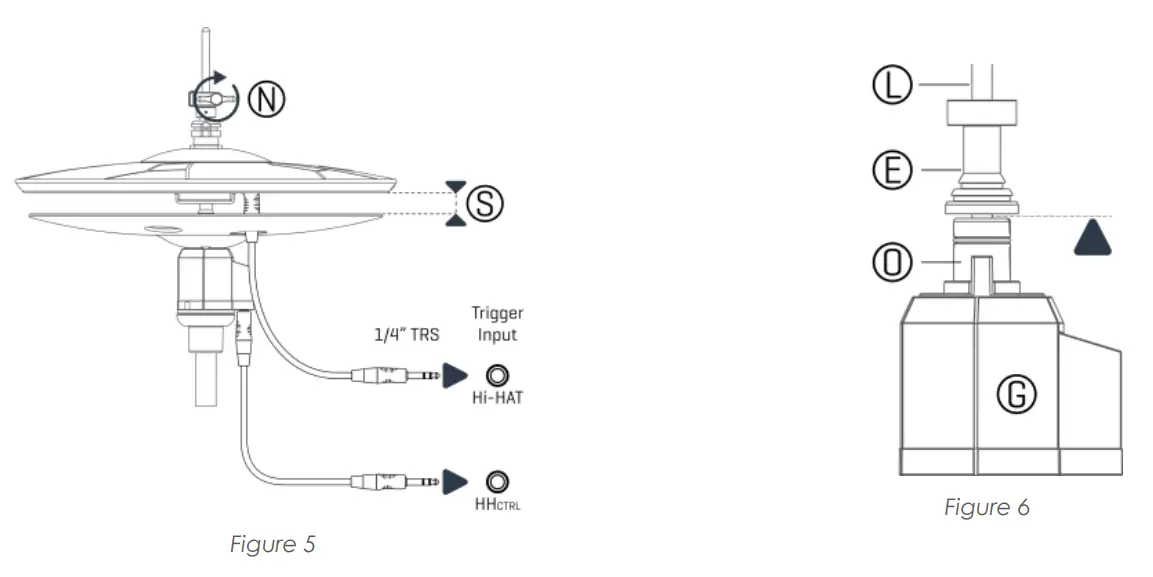

- Lift the top cymbal gradually, until the carriage of the Hi-Hat Controller (O) stops following the movement.
- In this position, fasten the clutch wing screw (N) as shown in Figure 5.
- After step 2, the Clutch Bumper (E) should be touching the carriage Hi-Hat Controller (O), without pressing the shaft down (see Figure 6). This corresponds to a inimum cymbal spacing (S) of approximately 19 mm (¾”).
- (Optional) Repeat steps 1-3 with a higher position of the top cymbal for wider cymbal spacing.
![]()
![]()
![]()
![]()
![]()
![]()
![]()
![]()
![]()
TRIGGER SETTINGS
![]()
![]()
GEWA consoles
| Trigger Bank: | GEWA HH14 |
| Input Channel: | Hi-Hat |
Other manufacturers*
- Check first whether your drum module supports the trigger types (Sensors) built into GEWA pads.
- Check whether the manufacturer of your module offers a trigger bank for the GEWA pad you want to connect.
- Consult the owner´s manual of your drum module for Information about trigger setups, accessible parameters and customization of 3 rd party equipment.
![]()
![]()
![]()
![]()
![]()
![]()
![]()
![]()
![]()
PLAYING TECHNIQUES
Hi-Hat PedalOpen-Closed
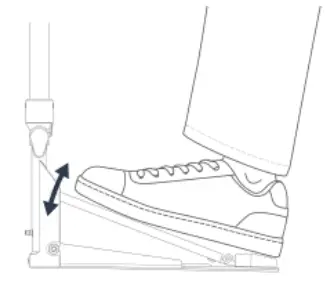

The Hi-Hat sound will vary in any of its sound components (Bell, Bow, Edge), depending on the angle of the foot board. In closed states, the controller can distinguish between splash techniques (short closing time) and chick techniques with longer closing times. The full potential of electronic Hi-Hats is described by the interplay between, Cymbal, ontroller, Pedal action and Sound Module.Closed with additional pressure
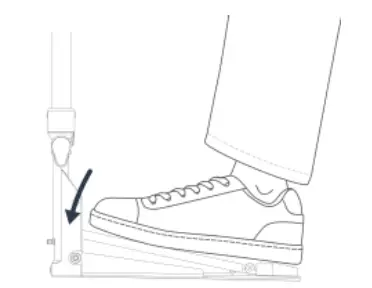

Applying even more pressure in closed states can alter the closed sound towards an even tighter sound. Hi-Hat sounds will become even sharper, while applying this technique to bass Drums, it can be utilized to mimic the effect of burying the beater (pitch bend).Hi-HatTip Stroke (Bow)
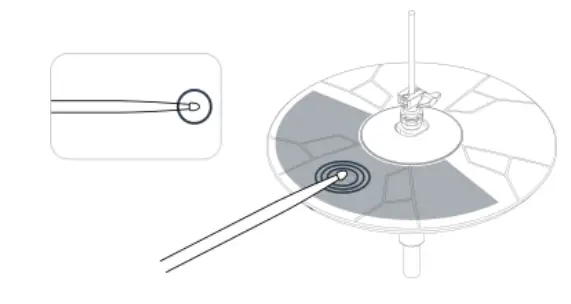

Strike the bow region with the tip of the stick within the highlighted area. This will trigger the bow sound. Use this technique in conjunction with the pedal techniques to roduce different sound qualities of the cymbals.Edge Stroke
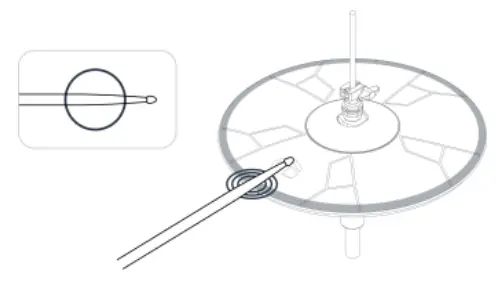

Strike the edge with the shoulder of the stick in the region of the edge sensor. This will trigger the edge sound. Use this technique in conjunction with the pedal techniques to roduceopen and closed edge sounds.Bell Stroke
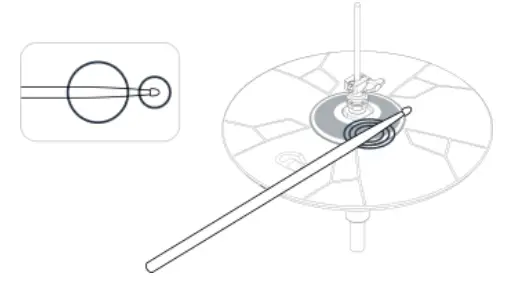

Bells on acoustic cymbals produce musical sounds using either the shoulder or thetip of the stick. Utilize both techniques to trigger the bell sound. Use this technique in onjunction with the pedal techniques to make use of the full range of bell sounds stored within a multi-layered sample.Cymbal Choke


After performing an Edge Stroke, subsequently apply pressure to the edge sensor using the fingers. This will prevent the edge sound from sustaining any longer. Regarding Hi- ats this technique is only practical for longer sounding,open sounds.With pressure applied to the edge, striking the cymbal will result in a short, staccato edge sound.
COMPATIBLE STANDS
Compatible Hi-Hat stands (HC14 & HHC)


The following measurements describe the minimum requirements for a Hi-Hat stand to fit the GEWA HHC Hi-Hat Controller. Note that the HHC is not a DIY product. It is a spare part for the HC14 Hi-Hat Cymbal and only works in conjunction with Clutch, Top Cymbal and Bottom Cymbal included with HC14. To prevent the Controller from spinning freely on the Hi-Hat seat, additional accessories might be required.
| Measure in [mm] | Measure in Inch [“] | |||
| A | Rod Diameter | max | 7 mm | ¼” |
| B | Excess Rod Length | min | 220 mm | 8 ¾” |
| C | Excess Sleeve Height | max | 25,4 mm | 1” |
| D | Hi-Hat Sleeve Width | max | 11,5 mm | 7/16” |
TECHNICAL DATA
HC14 Hi-Hat cymbal (Included with drum set configurations)
| Size | 14″ |
| Sensors | Bow (piezo ceramic element) |
| Edge & Choke (FSR Switch – MIDI velocity from piezo signal) | |
| Bell (FSR Switch – MIDI velocity from piezo signal) | |
| Choke | Yes |
| Connections | Trigger OutputHi-Hat Control OutputBell Trigger Output (optional for 3Way triggering) |
| Dimensions | 133 (H) x 355 (Ø) mm5 14 (H) x 14 (Ø) inches |
| Weight | 1280 g/ 2 lbs 13 oz |
| Accessories included | Owner’s manual (this document) |
HC14-AC Hi-Hat cymbal with accessories
| Size | 14″ |
| Sensors | Bow (piezo ceramic element) |
| Edge & Choke (FSR Switch – MIDI velocity from piezo signal) | |
| Bell (FSR Switch – MIDI velocity from piezo signal) | |
| Choke | Yes |
| Connections | Trigger OutputHi-Hat Control OutputBell Trigger Output (optional for 3Way triggering) |
| Dimensions | 133 (H) x 355 (Ø) mm5 1/2 (H) x 14 (Ø) inches |
| Weight | 1580 g / 3 lbs 8 oz |
| Accessories included | Hi-Hat clutch, 2 x 6,35 mm (1/4”) TRS stereo cables (Controller & Cymbal), owner´s manual (this document) |
HC14-T Hi-Hat top cymbal
| Size | 14″ |
| Sensors | Bow (piezo ceramic element) |
| Edge & Choke (FSR Switch – MIDI velocity from piezo signal) | |
| Bell (FSR Switch – MIDI velocity from piezo signal) | |
| Choke | Yes |
| Connections | Trigger OutputBell Trigger Output (optional for 3Way triggering) |
| Dimensions | 52 (H) x 355 (Ø) mm2 (H) x 14 (Ø) inches |
| Weight | 850 g/ 1 lb 14 oz |
| Accessories included | Owner’s manual (this document) |
![]()
![]()
![]()
![]()
![]()
![]()
![]()
![]()
![]()



References
Gewa Italia – GEWA music Italia
GEWA Drum Workstation G9
Gewa France – GEWA music France
Gewamusic – English
Gewa Česká republika – GEWA music Tschechien
Gewa Deutschland – we engineer music
Gewa Portugal – GEWA Portugal
Gewa International – GEWA music International
Gewa España
Gewa Polska – GEWA music Polen
Gewa Deutschland – we engineer music
[xyz-ips snippet=”download-snippet”]

